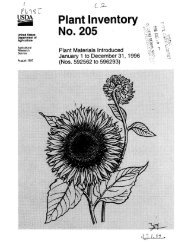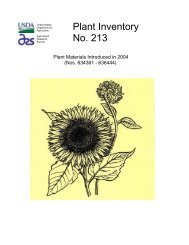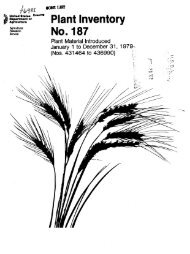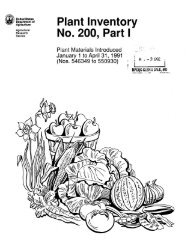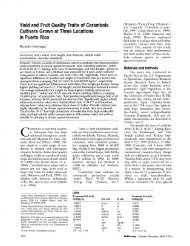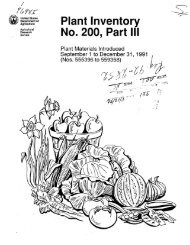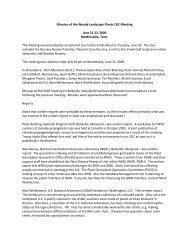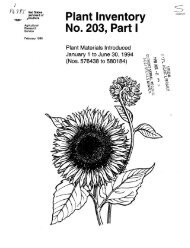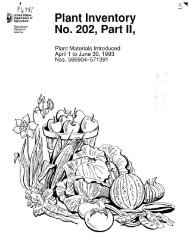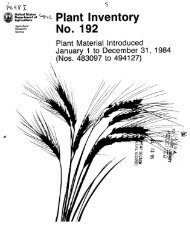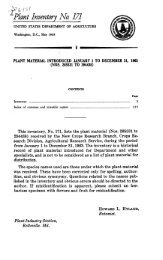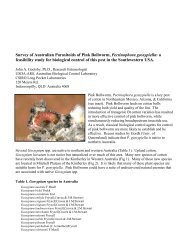In Vitro Tissue Culture of Pear: Advances in Techniques for ...
In Vitro Tissue Culture of Pear: Advances in Techniques for ...
In Vitro Tissue Culture of Pear: Advances in Techniques for ...
You also want an ePaper? Increase the reach of your titles
YUMPU automatically turns print PDFs into web optimized ePapers that Google loves.
<strong>In</strong> <strong>Vitro</strong> <strong>Tissue</strong> <strong>Culture</strong> <strong>of</strong> <strong>Pear</strong>: <strong>Advances</strong> <strong>in</strong> <strong>Techniques</strong> <strong>for</strong>Micropropagation and Germplasm PreservationR.L. BellU.S. Department <strong>of</strong> AgricultureAgricultural Research Service AgriculturalResearch ServiceAppalachian Fruit Research StationKearneysville, USAB.M. ReedU.S. Department <strong>of</strong> AgricultureNational Clonal Germplasm RepositoryCorvallis, USAKeywords: Pyrus, shoot proliferation, root<strong>in</strong>g, acclimation, cryopreservationAbstractMicropropagation techniques <strong>for</strong> over 20 pear (Pyrus) cultivars belong<strong>in</strong>g to sevenspecies have been reported. While most published methods use Murashige and Skoog(MS) basal nutrient medium, or slight modifications there<strong>of</strong>, Lepoivre (LP) and Driver-Kuniyuki Walnut (DKW) media, which differ from MS <strong>in</strong> nitrogen concentration orsource, and calcium concentration, have improved shoot proliferation rates. Solid mediagelled with agar, sometimes <strong>in</strong> comb<strong>in</strong>ation with gellan gum, have traditionally beenused, but two-phase liquid overlay or <strong>in</strong>termittent liquid immersion techniques havegreatly <strong>in</strong>creased shoot proliferation. <strong>In</strong> vitro culture methods, <strong>in</strong>clud<strong>in</strong>g meristemcryopreservation, are important facets <strong>of</strong> medium-term and long-term germplasmpreservation programs. Medium-term (1 to 4 years) storage techniques <strong>in</strong>volvetemperatures <strong>of</strong> 1 °C to 4 °C, usually <strong>in</strong> reduced light or darkness, <strong>in</strong> a nutrient mediumwith no growth regulators. Long-term preservation <strong>of</strong> meristems can be accomplishedby one <strong>of</strong> three major methods <strong>of</strong> cyropreservation: slow freez<strong>in</strong>g, vitrification, andencapsulation-dehydration. Slow freez<strong>in</strong>g, comb<strong>in</strong>ed with pretreatment by either coldacclimation or abscisic acid has proven to be particularly effective <strong>for</strong> Pyrus germplasm,<strong>in</strong>clud<strong>in</strong>g cold-tender species.INTRODUCTIONThe ability to establish shoot tip cultures, proliferate shoots, <strong>in</strong>duce root<strong>in</strong>g, andacclimatize the result<strong>in</strong>g plantlets are all elements <strong>of</strong> <strong>in</strong> vitro micropropagation. The methods<strong>of</strong>fer an alternative to the propagation <strong>of</strong> rootstocks by stool<strong>in</strong>g, layerage, or <strong>in</strong>duced root<strong>in</strong>g<strong>of</strong> s<strong>of</strong>twood, semi-hardwood, or hardwood cutt<strong>in</strong>gs (Hartmann et al., 1997; Howard, 1987).These same methods could also be used to produce self-rooted scion cultivars. General andgenotype-specific protocols that have been empirically developed <strong>for</strong> pear have been thesubject <strong>of</strong> previous reviews (Chevreau et al., 1992; Chevreau and Skirv<strong>in</strong>, 1992; Hutch<strong>in</strong>sonand Zimmerman, 1987; S<strong>in</strong>gha, 1986). Meristem culture has been used to produce pathogenfreeplants follow<strong>in</strong>g thermotherapy, and <strong>for</strong> cryopreservation <strong>of</strong> pear germplasm (Reed,1990). <strong>In</strong> vitro micropropagation methods are also general prerequisites to exploit<strong>in</strong>gsomaclonal variation and <strong>in</strong>duced mutations, and <strong>for</strong> the development <strong>of</strong> transgenic plants.MICROPROPAGATIONSpecies and GenotypesMicropropagation protocols have been published, beg<strong>in</strong>n<strong>in</strong>g <strong>in</strong> the late 1970's, <strong>for</strong>over 20 cultivars <strong>of</strong> pear, <strong>in</strong>clud<strong>in</strong>g the major Pyrus communis cultivars, but also severalJapanese cultivars <strong>of</strong> P. pyrifolia (Burm. f.) Nakai (Bhojwani et al., 1984), plus genotypes <strong>of</strong>P. amygdali<strong>for</strong>mis Villars (Dolcet-Sanjuan et al., 1990), P. calleryana Decne. (Berardi et al.,1992), P. X bretschneideri Rehder (Chevreau et al., 1989), P. pyraster L. (Damiano et al.1996), P. syriaca Boiss. (Shibli et al., 1997), and P. betulifolia Bunge (Nicolodi and Pieber,1989; Dolcet-Sanjuan et al., 1990), as well as <strong>for</strong> a qu<strong>in</strong>ce (Cydonia oblonga L.) rootstock(Dolcet-Sanjuan et al., 1990). Empirical studies to determ<strong>in</strong>e optimum cultivar-specificprotocols have been conducted <strong>for</strong> some, but not all <strong>of</strong> these genotypes: ‘Bartlett’ (Lane,412Proc.8th IS on <strong>Pear</strong>Eds. L. Corelli-Grappadelli et al.Acta Hort 596, ISHS 2002
1979; Shen and Mull<strong>in</strong>s, 1984), ‘Old Home’ x ‘Farm<strong>in</strong>gdale’ 51 rootstock (Cheng, 1979),‘Beurré Bosc’ (Shen and Mull<strong>in</strong>s, 1984; Bell et al., 1999), ‘Packham’s Triumph’ (Shen andMull<strong>in</strong>s, 1984), ‘Passe Crassane’ (Al Maarri et al., 1986; Leblay et al., 1991), ‘Conference’(Predieri et al., 1989; Leblay et al., 1991; De Paoli, 1989), ‘Louise Bonne’ (Chevreau et al.,1989), ’ Doyenne du Comice’ (De Paoli, 1989; Leblay et al., 1991), ‘Crystal’ (Chevreau etal., 1989), and ‘Hosui’ and four other Pyrus pyrifolia cultivars (Bhojwani et al., 1984;Hirabayashi et al., 1987).Shoot Proliferation Protocols<strong>In</strong> vitro establishment methods are fairly standard, with little variation. More variationexists <strong>in</strong> shoot proliferation media. The major factors are (1) macro- and micronutrientcomposition <strong>of</strong> the medium, and (2) phytohormones. Of eleven major media reported, mostused Murashige and Skoog (MS) (Murashige and Skoog, 1962) plant tissue culture medium,five without modification, and 2 with differences <strong>in</strong> the nitrogen concentration and type. Onlya few <strong>of</strong> the studies made comparisons among many basal media, so general conclusions aredifficult to make. Nedelcheva (1986) and Al Maarri et al. (1986) found that proliferation <strong>of</strong>‘Bartlett’ and ‘Passe Crassane’ was greatest on Lepoivre (LP) medium (Quoir<strong>in</strong> andLepoivre, 1977). <strong>In</strong> another study, DKW (Driver and Kuniyuki, 1984) has resulted <strong>in</strong> greatershoot proliferation than MS, LP, and Woody Plant Medium (WPM) (Lloyd and McCown,1981) <strong>for</strong> ‘Beurré Bosc’, and is at least as effective <strong>for</strong> ‘Bartlett’ as MS-based media (Bell etal., unpublished data). The major differences <strong>in</strong> macronutrients among these four basal mediaare <strong>in</strong> ammonium and nitrate ion concentrations and total ion concentration. Full-strength MSis highest <strong>in</strong> ammonium and nitrate, followed by DKW, while LP is a low ammoniummedium. Both LP and DKW have calcium nitrate as a major nitrogen source, and DKW ishighest <strong>in</strong> calcium.Benzyladen<strong>in</strong>e (BA) is the cytok<strong>in</strong><strong>in</strong> <strong>of</strong> choice <strong>for</strong> <strong>in</strong>duc<strong>in</strong>g axillary bud growth.Zeat<strong>in</strong> and 2-isopentenyladen<strong>in</strong>e (2-iP) have been rarely used, <strong>for</strong> example, as supplements toBA (Shen and Mull<strong>in</strong>s, 1984). Use <strong>of</strong> 2-iP tends to result <strong>in</strong> larger leaves, but <strong>in</strong> the absence<strong>of</strong> BA, results <strong>in</strong> decreased axillary budbreak (Bell, 1995; Moretti et al,, 1992).Concentrations <strong>of</strong> BA range from 2.2 M to 10 M.Aux<strong>in</strong>s have been used <strong>in</strong> most protocols. Eight <strong>of</strong> the media used <strong>in</strong>dole butyric acid(IBA) at 0.5 M, three media used naphthelene acetic acid (NAA), and only three reported nouse <strong>of</strong> aux<strong>in</strong> (Lane, 1979; Shen and Mull<strong>in</strong>s, 1984; and S<strong>in</strong>gha, 1980). Two media conta<strong>in</strong>edthe gibberell<strong>in</strong>, GA 3 at 0.3 or 0.6 M. However, Rodriguez et al. (1991) suggest that GA 3<strong>in</strong>hibited shoot proliferation <strong>in</strong> ‘Jules Guyot’ and ‘Butirra Precoce Morett<strong>in</strong>i’, and our owndata <strong>in</strong>dicates that GA 3 may <strong>in</strong>hibit shoot proliferation <strong>of</strong> ‘Bartlett’, but not ‘Beurré Bosc’.Rodriguez et al. (1991) also suggested that subsequent root<strong>in</strong>g was <strong>in</strong>hibited.Agar, usually at 6 g L -1 , is used predom<strong>in</strong>antly as a medium gell<strong>in</strong>g agent to providesupport to cultured tissues. A mixture <strong>of</strong> agar and gellan gum (Phytagel TM or Gelrite TM ) hasbeen used at the National Clonal Germplasm Repository (NCGR) <strong>for</strong> germplasm storage,primarily as a cost sav<strong>in</strong>g measure. De Paoli (1989) used a comb<strong>in</strong>ation <strong>of</strong> agar and pect<strong>in</strong>.Gellan gum alone tends to result <strong>in</strong> hyperhydricity <strong>of</strong> cultured tissue. Zimmerman et al.(1995) reported that the comb<strong>in</strong>ation <strong>of</strong> corn starch and gellan gum resulted <strong>in</strong> hyperhydricityand poor growth <strong>of</strong> ‘Seckel’ and ‘Beurre d’Anjou’. Addition <strong>of</strong> a hydric control agent (HCA),was successful <strong>in</strong> elim<strong>in</strong>at<strong>in</strong>g hyperhydricity. The use <strong>of</strong> a gellan gum-starch mixture as alow cost alternative to agar was, there<strong>for</strong>e, recommended, if also comb<strong>in</strong>ed with anappropriate HCA.Reported shoot multiplication rates have usually not exceeded 4-6 shoots per orig<strong>in</strong>alexplant. However, Bomm<strong>in</strong>eni et al. (2000) developed a rapid shoot multiplication technique<strong>in</strong>volv<strong>in</strong>g precondition<strong>in</strong>g <strong>in</strong> high concentrations <strong>of</strong> cytok<strong>in</strong><strong>in</strong>s to produce shoots with veryshort <strong>in</strong>ternodes with enlarged meristems, followed by th<strong>in</strong>-section<strong>in</strong>g to divide themeristems. Cultur<strong>in</strong>g the th<strong>in</strong> shoot slices on a shoot <strong>in</strong>duction medium produced multiplemeristems which developed <strong>in</strong>to shoots.Another promis<strong>in</strong>g technique is the use <strong>of</strong> a double-phase culture system, firstreported by Viseur (1987), <strong>in</strong> which an agar base is overlaid with liquid medium. More413
ecently, Rodriguez et al. (1991) demonstrated the effectiveness <strong>of</strong> this system with ‘AbbéFétel’, ‘Jules Guyot’, and ‘ Butirra Precoce Morett<strong>in</strong>i’, achiev<strong>in</strong>g multiplication rates as highas 15 shoots per explant. The double-phase system has become popular with commercialpropagators <strong>in</strong> the United States. An automated temporary (30 to 60 m<strong>in</strong>utes per day) liquidimmersion system has resulted <strong>in</strong> excellent shoot proliferation rates <strong>for</strong> Pyrus communis var.pyraster (Damiano et al. (1996) and ‘Conference’, ‘Precoce di Fiorano’, and ‘Harvest Queen’(Damiano et al., 2000), with neither the hyperhydricity <strong>of</strong>ten associated with liquid culture,nor the apical necrosis sometimes observed on solid media.Root<strong>in</strong>g ProtocolsRoot<strong>in</strong>g <strong>of</strong> <strong>in</strong> vitro produced shoots has changed little over the last 20 years. The twobasic methods <strong>in</strong>volve (1) a low concentration <strong>of</strong> aux<strong>in</strong> <strong>in</strong>corporated <strong>in</strong> semi-solid medium<strong>for</strong> a m<strong>in</strong>imum <strong>of</strong> 1 week, and (2) a quick (10 s to 1 m<strong>in</strong>) dip <strong>in</strong> a high concentration <strong>of</strong>aux<strong>in</strong>. <strong>In</strong> the <strong>for</strong>mer method, NAA or IBA at 0.1- 10 M, or IAA at 10 - 11 M have been used,while quick dip methods have used IBA at 10mM or 2000 mg L -1 concentrations. The basalmedium has typically been MS or half-strength MS. Light exclusion is typically not used, butmay <strong>in</strong>crease root<strong>in</strong>g. Yeo and Reed (1995) <strong>in</strong>vestigated several methods and found root<strong>in</strong>gfrequencies <strong>of</strong> 28 to 100% <strong>for</strong> 49 genotypes, depend<strong>in</strong>g on the treatment and genotype.Damiano et al. (2000) reported <strong>in</strong>consistent results with temporary immersion <strong>in</strong> root<strong>in</strong>gmedia conta<strong>in</strong><strong>in</strong>g the gibberell<strong>in</strong> <strong>in</strong>hibitors phlorogluc<strong>in</strong>ol, paclobutrazol, or flurprimidol.Damiano and Monticelli (1998) demonstrated that <strong>in</strong> vitro root<strong>in</strong>g <strong>of</strong> P. pyraster could beimproved by treatment with Agrobacterium rhizogenes.IN VITRO PRESERVATION OF PEAR GERMPLASMPrimary collections <strong>of</strong> plant germplasm are <strong>of</strong>ten <strong>in</strong> field plant<strong>in</strong>gs that are vulnerableto disease, <strong>in</strong>sect, and environmental stresses. Alternative germplasm storage technologiesprovide a secondary storage method <strong>for</strong> clonal field collections, storage <strong>for</strong> experimentalmaterial, allow <strong>for</strong> stag<strong>in</strong>g <strong>of</strong> commercial tissue culture crops, and provide a reserve <strong>of</strong>germplasm <strong>for</strong> plant distribution. Cryopreservation <strong>in</strong> liquid nitrogen (LN) allows storage <strong>of</strong>a base collection (long-term backup) <strong>of</strong> clonal materials. Cryopreservation methods are nowwell developed and make these long-term collections <strong>of</strong> clonal germplasm feasible. Both <strong>in</strong>vitro and cryopreserved collections provide <strong>in</strong>surance aga<strong>in</strong>st the loss <strong>of</strong> valuable geneticresources and may provide alternative distribution methods.<strong>In</strong> <strong>Vitro</strong> StorageMedium-term storage <strong>of</strong> clonal plants <strong>in</strong>volves strategies to slow growth throughtemperature reduction, environmental manipulation, or chemical additions <strong>in</strong> the culturemedium (Wanas et al., 1986). Several laboratories have developed strategies <strong>for</strong> slow-growthstorage <strong>of</strong> pears. A standard storage treatment <strong>for</strong> Pyrus communis and many other species is4 °C with a 16-h photoperiod <strong>for</strong> 12 to 18 months. <strong>In</strong> comparison, the Japanese pears, P.pyrifolia, survive best when stored at 1 °C <strong>in</strong> the dark <strong>for</strong> 12 months (Moriguchi et al., 1990;Moriguchi, 1995). <strong>Pear</strong>s stored at NCGR-Corvallis <strong>in</strong> 1984 were successfully stored <strong>in</strong> 20 x100 mm tubes at 4 °C <strong>in</strong> darkness, but tubes were replaced with gas-permeable tissue-culturebags <strong>in</strong> 1989. Pyrus accessions (n = 169) stored <strong>in</strong> these tissue-culture bags <strong>in</strong> the dark at4 °C had a mean storage life <strong>of</strong> 2.7 years (range from eight months to 4.6 yr) (Reed andChang, 1997). Three cold-storage treatments (1 o C upright plants, 4 o C 3/4 submerged, 1 °Cupright) revealed differences among the 46 genotypes <strong>for</strong> storage duration, but fewdifferences were noted among the treatments <strong>for</strong> a s<strong>in</strong>gle genotype (Reed et. al., 1998b).CryopreservationNew techniques and improvements <strong>in</strong> cryopreservation research have greatly<strong>in</strong>creased the number <strong>of</strong> cryopreserved species. Suspension or callus cultures, dormant buds,<strong>in</strong> vitro-grown apical meristems, isolated embryonic axes, seeds, somatic embryos, andpollen are now stored <strong>in</strong> LN. Dormant bud cryopreservation started with Sakai’s earlyexperiments on fruit trees (summarized <strong>in</strong> Sakai, 1985). More recent work with dormant,414
cold-hardy Pyrus shoots has been very successful (Moriguchi et al., 1985; Oka et al., 1991;Mi and Sanada, 1992; 1994).The three major meristem cryopreservation techniques, slow freez<strong>in</strong>g, vitrification,and encapsulation-dehydration, provide options <strong>for</strong> most types <strong>of</strong> plant materials (Benson,1999). <strong>In</strong> vitro-grown pear shoot meristems were first successfully cryopreserved <strong>in</strong> 1990(Dereuddre et al., 1990a; b; Reed, 1990). A slow freez<strong>in</strong>g method <strong>for</strong> <strong>in</strong> vitro-grown pearmeristems 55% to 95% regrowth <strong>of</strong> four Pyrus species <strong>in</strong>clud<strong>in</strong>g a subtropical species,P. koehnei (Reed, 1990). Encapsulation-dehydration was applied to pear by Dereuddre et al.,(1990a; b). A 0.75 M sucrose preculture and 4-hr dehydration (20% residual water) produced80% recovery (Scottez et al., 1992). A modified encapsulation-dehydration methoddeveloped by Ni<strong>in</strong>o and Sakai (1992) produced 70% recovery, and their vitrification method40% to 72.5% regrowth (Ni<strong>in</strong>o et al., 1992; Suzuki et al., 1997). A comparison <strong>of</strong> slowfreez<strong>in</strong>g and vitrification methods us<strong>in</strong>g 28 Pyrus genotypes found that 61% had better than50% regrowth follow<strong>in</strong>g slow freez<strong>in</strong>g (0.1 °C/m<strong>in</strong>), while only 43% responded this well tothe vitrification technique (Luo et al., 1995; Reed et al., 1998a).Recent studies show that pretreatment <strong>of</strong> stock plants with cold acclimation (CA) orabscisic acid (ABA) is very important <strong>for</strong> cryopreservation <strong>of</strong> many pear genotypes.Alternat<strong>in</strong>g-temperature (22 °C <strong>for</strong> 8-12 h/-1 o C <strong>for</strong> 12-16 h) CA <strong>for</strong> 2 to 5 weeks significantly<strong>in</strong>creases regrowth, and recovery rema<strong>in</strong>s high <strong>for</strong> shoots with up to 15 weeks <strong>of</strong> CA.Constant temperature acclimation is less effective (Chang and Reed, 2000). Abscisic acid <strong>in</strong>the preculture medium shortens the acclimation period from 10 days to 2 weeks <strong>for</strong>P. cordata, a particularly difficult taxon to cryopreserve (Chang and Reed, 2001).CONCLUSIONSFortunately, <strong>in</strong> vitro culture and cryopreservation have progressed to the po<strong>in</strong>t wherethey can be used rout<strong>in</strong>ely <strong>in</strong> many laboratories. Important advances have been made <strong>in</strong>proliferation, particulary with the development <strong>of</strong> liquid immersion techniques, and <strong>in</strong>genotype-specific root<strong>in</strong>g protocols. <strong>In</strong> vitro-stored plantlets are used as primary or duplicatecollections <strong>in</strong> several facilities. Long-term (base) storage <strong>of</strong> important collections throughcryopreservation <strong>of</strong> meristems is now a reality as well (Reed et al., 1998b; Reed, 1999).Cryopreserved meristems provide an important, previously miss<strong>in</strong>g, <strong>for</strong>m <strong>of</strong> long termgermplasm storage <strong>for</strong> vegetatively propagated plants. The greatest cost <strong>of</strong> cryopreservationis <strong>in</strong> the <strong>in</strong>itial storage <strong>of</strong> an accession, but very little <strong>in</strong>put is needed <strong>for</strong> many years afterstorage. <strong>In</strong>itial storage costs are <strong>of</strong>ten similar to the cost <strong>of</strong> ma<strong>in</strong>ta<strong>in</strong><strong>in</strong>g accessions <strong>in</strong> the field<strong>for</strong> one year. Costs <strong>for</strong> ma<strong>in</strong>tenance <strong>in</strong> LN are m<strong>in</strong>imal. Although plants can be distributed ascryopreserved samples, they are best kept as <strong>in</strong>surance <strong>in</strong> case <strong>of</strong> loss <strong>of</strong> actively grow<strong>in</strong>gaccessions.Literature CitedAl Maarri, K., Duron, M., Arnaud, Y. and Mig<strong>in</strong>iaaac, E. 1986. Etude comparative del’aptitude a la micropropagation, par culture de meristemes <strong>in</strong> vitro, du poiriers juvenilesissus de semis de ‘Passe Crassane’. C.R. Acad. Agric. Fr. 72:413-421.Bell, R.L. 1995. Precondition<strong>in</strong>g effects <strong>of</strong> proliferation medium on adventitious regeneration<strong>of</strong> pear. HortScience 30:832.Bell, R. L., Scorza, R., Sr<strong>in</strong>ivasan, C, and Webb, K. 1999. Trans<strong>for</strong>mation <strong>of</strong> ‘Beurré Bosc’pear with the rolC gene. J. Amer. Soc. Hort. Sci. 124:570-574.Benson E.E. 1999. Plant Conservation Biotechnology. Taylor and Francis Ltd., London UK.Berardi, G., <strong>In</strong>fante, R., and Neri, D. 1992. Micropropagation <strong>of</strong> Pyrus calleryana Dcn. fromseedl<strong>in</strong>gs. Sci. Hortic. 53:157-165.Bhojwani, S.S., Mull<strong>in</strong>s, K., and Cohen, D. 1984. <strong>In</strong> vitro propagation <strong>of</strong> Pyrus pyrifolia. Sci.Hortic. 23:247-254.Bomm<strong>in</strong>eni, V.R., Mathews, H., Samuel, S.B., Webb, N., Kramer, M. and Wagner, D.R.2000. An enhanced <strong>in</strong> vitro propagation method <strong>for</strong> rapid clonal multiplication <strong>of</strong> pear(Pyrus communis cv Bartlett). <strong>In</strong>: <strong>In</strong>tl. Soc. Hort. Sci, VII <strong>In</strong>tl. Symp. on <strong>Pear</strong>. Ferrara-Bologna, Italy, September 4-9, 2000. Abstracts. p. 119.415
Chang, Y. and Reed, B.M. 2000. Extended alternat<strong>in</strong>g-temperature cold acclimation andculture duration improve pear shoot cryopreservation. Cryobiology 40:311-322.Chang, Y. and Reed, B.M. 2001. Preculture conditions <strong>in</strong>fluence cold hard<strong>in</strong>ess and regrowth<strong>of</strong> Pyrus cordata shoot tips after cryopreservation. HortScience 36:1329-1333.Cheng, T.Y. 1979. Micropropagation <strong>of</strong> clonal fruit tree rootstocks. Compact Fruit Tree12:127-137.Chevreau, E., Skirv<strong>in</strong>, R.M., Abu-Qaoud, H.A., Korban, S.S. and Sullivan, J.G. 1989.Adventitious shoot regeneration from leaf tissue <strong>of</strong> three pear (Pyrus sp.) cultivars <strong>in</strong>vitro. Plant Cell Rep. 7:688-691.Chevreau, E.,B. Thibault and Y. Arnaud. 1992. Micropropagation <strong>of</strong> pear (Pyrus communisL.). <strong>In</strong>: Y. P. S. Bajaj (ed.), Biotechnology <strong>in</strong> agriculture and <strong>for</strong>estry, Vol. 18. Spr<strong>in</strong>ger-Verlag, Berl<strong>in</strong>. p. 224-261.Chevreau, E. and Skirv<strong>in</strong>, R.M. 1992. <strong>Pear</strong>. <strong>In</strong>: F.A. Hammerschlag, and R.E. Litz. (eds.).Biotechnology <strong>in</strong> agriculture, Vol 8. Biotechnology <strong>of</strong> perennial fruit crops. C.A.B. <strong>In</strong>tl.p. 263-276.Damiano, C., Liberali, M., Avanzato, D., and Preka, P. 1996. Micropropagazione di Pyruscommunis var. pyraster. Macfrut: Agro. Bio. Frut. Cesena, 10-11 May. p. 132-133.Damiano, C., and Monticelli, S. 1998. <strong>In</strong> vitro fruit trees root<strong>in</strong>g by Agrobacteriumrhizogenes wild type <strong>in</strong>fection. Electronic J. Biotech. 1(2):1-7.Damiano, C., Frattarelli, A. and Giorgioni, M. 2000. Micropropagation <strong>of</strong> temperate fruittrees through temporary immersion technique: the case <strong>of</strong> pear. <strong>In</strong>: <strong>In</strong>tl Soc. Hort. Sci, VII<strong>In</strong>tl. Symp. on <strong>Pear</strong>. Ferrara-Bologna, Italy, September 4-9, 2000. Abstracts. p. 120-121.De Paoli, G. 1989. Micropropagazione delle varietà di pero. <strong>In</strong>f. Agrar 43:71-73.Dereuddre, J., Scottez, C., Arnaud, Y. and Duron, M. 1990a. Resistance <strong>of</strong> alg<strong>in</strong>ate-coatedaxillary shoot tips <strong>of</strong> pear tree (Pyrus communis L. cv. Beurré Hardy) <strong>in</strong> vitro plantlets todehydration and subsequent freez<strong>in</strong>g <strong>in</strong> liquid nitrogen. C. R. Acad. Sci. Paris 310:317-323.Dereuddre, J., Scottez, C., Arnaud, Y. and Duron, M. 1990b. Effects <strong>of</strong> cold harden<strong>in</strong>g oncryopreservation <strong>of</strong> axillary pear (Pyrus communis L. cv. Beurré Hardy) shoot tips <strong>of</strong> <strong>in</strong>vitro plantlets. C. R. Acad. Sci. Paris 310:265-272.Dolcet-Sanjuan, R., Mok, D.W.S. and Mok, M.C. 1990. Micropropagatio<strong>in</strong> <strong>of</strong> Pyrus andCydonia and their responses to Fe-limit<strong>in</strong>g conditions. Plant Cell Tiss. Org. <strong>Culture</strong>21:191-199.Driver, J.A. and Kuniyuki, H. 1984. <strong>In</strong> vitro propagation <strong>of</strong> Paradox walnut rootstock.HortScience 19:507-509.Hartmann, H.T., Kester, D.E., Davies, F.T. and Geneve, R.L. 1997. Plant propagation:pr<strong>in</strong>ciples and practices. 6th Edition. Chapter 18. <strong>Techniques</strong> <strong>of</strong> <strong>in</strong> vitro culture <strong>for</strong>micropropagation and biotechnology. Prentice-Hall, Upper Saddle River. p. 590-624.Hirabayashi, T., Moriguchi, T., Kozaki, I., Yamamoto, Y. and Matsuzaki, S. 1987. <strong>In</strong> vitropropagation <strong>of</strong> Pyrus shoot tips. Bull. Fruit Tree Res. Sta. 14:9-16.Howard, B.H. 1987. Propagation. <strong>In</strong>: R. C. Rom and R. F. Carlson (eds.), Rootstocks <strong>for</strong> fruitcrops. John Wiley & Sons, New York. p. 9-77.Hutch<strong>in</strong>son, J.F. and Zimmerman, R.H. 1989. <strong>Tissue</strong> culture <strong>of</strong> temperate fruit and nut trees.Hort. Rev. 9:273-349.Lane, W.D. 1979. Regeneration <strong>of</strong> pear plants from shoot meristem-tips. Plant Sci. Lett.16:337-342.Leblay, C., Chevreau, E. and Rabo<strong>in</strong>, L.M. 1991. Adventitious shoot regeneration from <strong>in</strong>vitro leaves <strong>of</strong> several pear cultivars (Pyrus communis). Plant Cell Tiss. Org. Cult. 16:75-87.Lloyd, G. and McCown, B. 1981. Commercially-feasible micropropagation <strong>of</strong> mounta<strong>in</strong>laurel, Kalmia latifolia, by use <strong>of</strong> shoot tip culture. <strong>In</strong>tl. Plant Prop. Soc. Comb. Proc.30:421-427.Luo, J., DeNoma, J. and Reed, B.M. 1995. Cryopreservation screen<strong>in</strong>g <strong>of</strong> Pyrus germplasm.Cryobiology 32:558.Mi, W. and Sanada, T. 1992. Cryopreservation <strong>of</strong> pear w<strong>in</strong>ter buds and shoot tips. Ch<strong>in</strong>a416
Fruits, 20-22 and 38.Mi, W. and Sanada, T. 1994. Cryopreservation <strong>of</strong> pear shoot tips <strong>in</strong> vitro. <strong>Advances</strong> <strong>in</strong>Horticulture, 86-88.Moretti, C., Scozzoli, A., Pas<strong>in</strong>i, D. and Paganelli, F. 1992. <strong>In</strong> vitro propagation <strong>of</strong> pearcultivars. Acta Hort. 300:115-118.Moriguchi, T. 1995. Cryopreservation and m<strong>in</strong>imum growth storage <strong>of</strong> pear (Pyrus species).<strong>In</strong>: Y.P.S. Bajaj (ed.). Biotechnology <strong>in</strong> Agriculture and Forestry, Vol. 32. Spr<strong>in</strong>ger-Verlag: Berl<strong>in</strong>, Heidelberg. p. 114-128.Moriguchi, T., Akihama, T. and Kozaki, I. 1985. Freeze-preservation <strong>of</strong> dormant pear shootapices. Jap. J. Breed. 35:196-199.Moriguchi, T., Kozaki, I., Yamaki, S. and Sanada, T. 1990. Low temperature storage <strong>of</strong> pearshoots <strong>in</strong> vitro. Bull. Fruit Tree Res. Sta. 17:11-18.Murashige, T. and Skoog, F. 1962. A revised medium <strong>for</strong> rapid growth and bioassays withtobacco tissue cultures. Physiol. Plant. 15:473-497.Nedelcheva, S. 1986. Effect <strong>of</strong> <strong>in</strong>organic components <strong>of</strong> the nutrient medium on <strong>in</strong> vitropropagation <strong>of</strong> pears. Genet. Sel. 19:404-406. (<strong>In</strong> Russian)Nicolodi, R. and Pieber, K. 1989. Micropropagation experiments with Pyrus betulaefolia.Mitt Klosterneuburg Rebe We<strong>in</strong> Obstau Fruchteverwertung 39:6247-6250.Ni<strong>in</strong>o, T. and Sakai, A. 1992, Cryopreservation <strong>of</strong> alg<strong>in</strong>ate-coated <strong>in</strong> vitro-grown shoot tips<strong>of</strong> apple, pear and mulberry. Plant Science 87:199-206.Ni<strong>in</strong>o, T., Sakai, A., Yakuwa, H. and Nojiri, K. 1992. Cryopreservation <strong>of</strong> <strong>in</strong> vitro-grownshoot tips <strong>of</strong> apple and pear by vitrification. Plant Cell Tiss. Org. <strong>Culture</strong> 28:261-266.Oka, S., Yakuwa, H., Sato, K. and Ni<strong>in</strong>o, T. 1991. Survival and shoot <strong>for</strong>mation <strong>in</strong> vitro <strong>of</strong>pear w<strong>in</strong>ter buds cryopreserved <strong>in</strong> liquid nitrogen. HortScience 26:65-66.Predieri, S., Fasolo Fabbri Malavasi, F., Passey, A. J., Ridout, M.S. and James, D. J. 1989.Regeneration from <strong>in</strong> vitro leaves <strong>of</strong> ‘Conference’ and other pear cultivars (Pyruscommunis). J. Hort. Sci. 64:553-559.Quoir<strong>in</strong>, M. and Lepoivre, P. 1977. Etude de milieux adaptes aux cultures <strong>in</strong> vitro de Prunus.Acta Hort. 78:437-442.Reed, B.M. 1990. Survival <strong>of</strong> <strong>in</strong> vitro-grown apical meristems <strong>of</strong> Pyrus follow<strong>in</strong>gcryopreservation. HortScience 25:111-113.Reed, B.M. 1999. <strong>In</strong> vitro conservation <strong>of</strong> temperate tree fruit and nut crops. <strong>In</strong>: E.E. Benson(ed.). Plant Conservation Biotechnology. Taylor and Francis, London p. 139-153.Reed, B.M. and Chang, Y. 1997. Medium- and Long-Term Storage <strong>of</strong> <strong>In</strong> vitro <strong>Culture</strong>s <strong>of</strong>Temperate Fruit and Nut Crops. <strong>In</strong>: M.K. Razdan and E.C. Cock<strong>in</strong>g (eds.). Conservation<strong>of</strong> Plant Genetic Resources <strong>In</strong> <strong>Vitro</strong>, Vol. 1. Science Publishers, Enfield, NH. p. 67-105.Reed, B.M., DeNoma, J., Luo, J., Chang, Y. and Towill, L. 1998a, Cryopreservation andlong-term storage <strong>of</strong> pear germplasm. <strong>In</strong> <strong>Vitro</strong> Cell. Devel. Biol. 34, 256-260.Reed, B.M., Paynter, C.L., DeNoma, J., and Y. Chang. 1998b. <strong>Techniques</strong> <strong>for</strong> medium andlong-term storage <strong>of</strong> pear (Pyrus L.) genetic resources. FAO/IPGRI Plant GeneticResources Newsletter 115:1-5.Rodriguez, R., Diaz-Sala, C., Cuozzo, L., and Ancora, G. 1991. <strong>Pear</strong> <strong>in</strong> vitro propagationus<strong>in</strong>g a double-phase culture system. HortScience 26:62-64.Sakai, A. 1985. Cryopreservation <strong>of</strong> shoot-tips <strong>of</strong> fruit trees and herbaceous plants. <strong>In</strong>: K.K.Kartha (ed.). Cryopreservation <strong>of</strong> Plant Cells and <strong>Tissue</strong>s. CRC Press, Boca Raton, FL. p.135-170.Scottez, C., Chevreau, E., Godard, N., Arnaud, Y., Duron, M. and Dereuddre, J. 1992.Cryopreservation <strong>of</strong> cold acclimated shoot tips <strong>of</strong> pear <strong>in</strong> vitro cultures afterencapsulation-dehydration. Cryobiology, 29:691-700.Shen, X.S. and Mull<strong>in</strong>s, M. G. 1984. Propagation <strong>in</strong> vitro <strong>of</strong> pear, Pyrus communis L.cultivars ‘William’s Bon Chretien’, ‘Packham’s Triumph’, and ‘Beurré Bosc’. Sci. Hort.23:51-57.Shibli, R.A., Ajlouni, M.M., Jaradat, A., Aljanabi, S. and Shatnawi, M. 1997.Micropropagation <strong>in</strong> wild pear (Pyrus syriaca). Sci. Hortic. 68:237-242.S<strong>in</strong>gha, S. 1980. <strong>In</strong> vitro propagation <strong>of</strong> ‘Seckel’ pear. <strong>In</strong>: Proceed<strong>in</strong>gs <strong>of</strong> the conference on417
nursery production <strong>of</strong> fruit plants through tissue culture: application and feasibility, 21-22April 1980, Beltsville. U. S. Dept.Agric., Sci.& Educ. Adm., ARR-NE-11 p. 59-63.S<strong>in</strong>gha, S. 1986. <strong>Pear</strong> (Pyrus communis). <strong>In</strong>: Bajaj, Y.P.S. (ed.). Biotechnology <strong>in</strong> agricultureand <strong>for</strong>estry. Vol. I. Spr<strong>in</strong>ger-Verlag, New York, p. 198-206.Suzuki, M., Ni<strong>in</strong>o, T., Akihama, T. and Oka, S. 1997. Shoot <strong>for</strong>mation and plant regeneration<strong>of</strong> vegetative pear buds cryopreserved at -150 degrees C. J. Japan. Soc. Hort. Sci. 66:29-34.Viseur, J. 1987. Micropropagation <strong>of</strong> pear, Pyrus communis L., <strong>in</strong> a double-phase culturemedium. Acta Hort. 212:117-124.Wanas, W.H., Callow, J.A. and Withers, L.A. 1986. Growth limitations <strong>for</strong> the conservation<strong>of</strong> pear genotypes. <strong>In</strong>: L.A. Withers and P.G. Alderson (eds.). Plant <strong>Tissue</strong> <strong>Culture</strong> and ItsAgricultural Applications. Butterworths: London. p. 285-290.Yeo, D.Y., and Reed, B. M. 1995. Micropropagation <strong>of</strong> three Pyrus rootstocks. HortScience30:620-623.Zimmerman, R.H., Bhardwaj, S.V. and Fordham, I.M. 1995. Use <strong>of</strong> starch-gelled medium <strong>for</strong>tissue culture <strong>of</strong> some fruit crops. Plant Cell Tiss. Org. <strong>Culture</strong> 43:307-313.418




